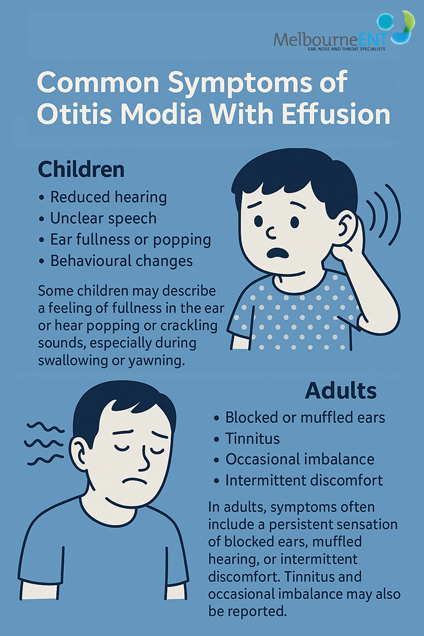
At Melbourne ENT, located in St Kilda East, Victoria, we provide world-class care for both children and adults suffering from Otitis Media With Effusion (OME), commonly referred to as “glue ear.” This frequently encountered condition can significantly impact hearing and speech development in children and cause discomfort and frustration in adults.
Our practice is led by two of Melbourne’s most trusted ENT surgeons, Dr Stephen Kleid and Dr Simon Braham. Both are Fellows of the Royal Australasian College of Surgeons and are committed to delivering personalised, evidence-based ENT care.
Melbourne ENT specialises in diagnosing and managing a wide range of ENT conditions. We combine compassionate care with advanced diagnostics and modern treatment options to help patients of all ages achieve the best possible outcomes. Whether you are concerned about your child’s hearing or experiencing ongoing ear fullness or discomfort yourself, our team is here to help.
What Is Otitis Media With Effusion?
Otitis Media With Effusion is a condition where fluid accumulates in the middle ear behind the eardrum, without causing acute infection symptoms such as pain or fever. The retained fluid often becomes thick and sticky, leading to the common term “glue ear.” Although OME does not present with the sharp symptoms of an ear infection, it can significantly interfere with hearing. This is particularly important in young children, as clear hearing is essential for proper speech and language development.
OME usually occurs due to poor drainage of the middle ear through the Eustachian tube, which connects the ear to the back of the throat. When this tube becomes blocked, often due to colds, allergies, or sinus congestion, fluid is unable to escape and builds up over time. In many children, the Eustachian tube is anatomically narrower and more horizontal, making them more susceptible to this condition.

Common Symptoms of Otitis Media With Effusion
The symptoms of OME can be subtle and may vary depending on age. In children, the most noticeable sign is reduced hearing. Parents may observe that their child appears to ignore spoken instructions, frequently asks for repetition, or turns up the volume on electronic devices. They might also notice that their child’s speech is unclear or not developing as expected.
Some children may describe a feeling of fullness in the ear or hear popping or crackling sounds, especially during swallowing or yawning. Behavioural changes such as irritability, inattentiveness, or difficulty concentrating at school can sometimes be traced back to undiagnosed OME.
In adults, symptoms often include a persistent sensation of blocked ears, muffled hearing, or intermittent discomfort. Tinnitus and occasional imbalance may also be reported. Although OME is less common in adults, it can still occur, particularly after upper respiratory infections or exposure to allergens.
Who Is Affected by Otitis Media With Effusion?
OME predominantly affects children under the age of six due to their developing anatomy and immune systems. Their Eustachian tubes are shorter, more horizontal, and more prone to blockage by mucus or inflammation. Children attending daycare, exposed to tobacco smoke, or who experience frequent colds are particularly at risk. Certain anatomical variations such as cleft palate or Down syndrome further increase susceptibility.
While OME is most prevalent in young children, it is not limited to them. Teenagers and adults may also develop OME, particularly following sinus infections, seasonal allergies, or during recovery from colds and flu. Adults with structural nasal issues or a history of chronic rhinosinusitis may find that OME becomes a recurring issue, impacting hearing and overall quality of life.
Diagnosis and Evaluation at Melbourne ENT
At Melbourne ENT, we take a thorough and patient-centred approach to diagnosing OME. The process begins with a detailed clinical history, during which we explore symptom duration, frequency, impact on hearing or development, and any underlying risk factors such as allergies or previous infections.
A physical examination using an otoscope allows us to visualise the eardrum for signs of fluid, retraction, or reduced mobility. Tympanometry is often performed to assess how the eardrum responds to pressure changes. This non-invasive test provides a clear indication of fluid presence in the middle ear.
If hearing loss is suspected, a formal hearing test may be arranged. For children, this can help determine how much the fluid is affecting their ability to perceive speech sounds. In some cases, we may use a nasendoscope to assess the nasal passages and adenoids, especially if enlarged adenoids are suspected of obstructing the Eustachian tubes.
This thorough assessment ensures that we identify the exact cause and extent of OME, allowing us to recommend the most effective treatment plan.
Treatment Options for Otitis Media With Effusion
Treatment for OME depends on how long the fluid has been present and how much it is impacting hearing, speech, or daily functioning. In many cases, particularly after a cold, the fluid will resolve spontaneously over several weeks. For children with no developmental delays and mild symptoms, a watchful waiting approach may be appropriate. During this time, we monitor symptoms and hearing levels closely.
When OME persists beyond three months or causes moderate to severe hearing loss, surgical treatment is usually recommended. The most common procedure is grommet insertion. Grommets are tiny ventilation tubes placed in the eardrum to allow air into the middle ear and drain the fluid. The procedure is brief, low-risk, and typically performed as day surgery under general anaesthetic. Hearing often improves within days.
In cases where enlarged adenoids contribute to chronic Eustachian tube dysfunction, adenoidectomy may be recommended. Removing the adenoids can help prevent recurrence and support better nasal and ear health overall.
For adults or children who are not suitable candidates for surgery, hearing aids may be considered. These devices can temporarily improve hearing until the fluid resolves or until surgery becomes a viable option.
When Is Surgery Recommended?
Surgery is considered when OME has lasted longer than three months, and hearing loss is confirmed by testing. It is also recommended when there is evidence of speech or developmental delay, behavioural problems related to hearing, or recurrent episodes of middle ear effusion. Grommet insertion is particularly effective for children experiencing frequent ear infections or fluid-related hearing difficulties that interfere with learning and communication.
In adults, persistent OME that does not respond to medical therapy or significantly affects quality of life may also require surgical intervention. Grommet placement offers reliable relief and improved hearing for many adult patients.
Our surgeons carefully assess each case and explain all options to ensure that surgery is only performed when it is truly in the patient’s best interest.
Recovery and Prognosis
Recovery after grommet insertion is usually quick and straightforward. Most children return to normal activities, including school or childcare, within 24 to 48 hours. Discomfort is minimal, and post-operative complications are rare. Hearing typically improves within a few days as the fluid drains and air returns to the middle ear.
Grommets generally stay in place for six to twelve months before naturally falling out as the eardrum heals. Follow-up appointments are scheduled to monitor hearing, check the position of the grommets, and ensure there are no new concerns.
The long-term outlook for children and adults treated for OME is excellent. With timely treatment, most children catch up rapidly in speech, language, and academic performance. Adults often report improved hearing and reduced pressure or discomfort, enhancing their ability to engage at work or in social situations.
Risks or Complications if Left Untreated
Although OME is not painful, ignoring persistent symptoms can lead to significant issues. In children, untreated OME can result in prolonged hearing loss during critical periods of language and social development. This may lead to delayed speech, learning difficulties, and behavioural problems. Without intervention, a child may fall behind at school or struggle to communicate effectively with peers and adults.
In adults, chronic OME can cause ongoing frustration, reduced hearing clarity, and impaired communication. Long-term fluid retention may lead to damage to the eardrum or middle ear structures, increasing the risk of chronic ear disease including cholesteatoma formation.
Prompt evaluation and appropriate treatment significantly reduce these risks and improve quality of life for both children and adults.
Why Choose Your Surgeon
At Melbourne ENT, we are proud to offer ENT care led by two highly experienced and respected surgeons.
Dr Stephen Kleid has decades of experience in treating adult and complex ENT conditions. A senior surgeon at Peter MacCallum Cancer Centre and former Head of Department at Royal Melbourne Hospital, he brings a depth of expertise in diagnosing and managing ENT issues with care and precision. Dr Kleid is actively involved in medical education and research and is known for his thoughtful, evidence-based approach.
Dr Simon Braham is a specialist ENT surgeon with a strong focus on paediatric ear, nose, and throat conditions. He has trained in Australia and internationally and is known for his gentle, patient-first approach with children and families. Dr Braham holds appointments at Masada Private Hospital and the Royal Victorian Eye and Ear Hospital and is dedicated to helping children with hearing loss and ENT concerns thrive in their development.
Together, our surgeons provide comprehensive ENT care for patients across all age groups, supported by a compassionate team and advanced clinical facilities. From initial consultation to post-operative follow-up, we are committed to ensuring every patient feels heard, respected, and involved in their care.
FAQs About Otitis Media With Effusion
What if my child’s hearing seems to vary from day to day – could that still be OME?
Yes, fluctuating hearing is a hallmark of OME. The fluid behind the eardrum may shift with changes in pressure, body position, or nasal congestion, leading to intermittent hearing changes. It’s important not to dismiss variable symptoms as insignificant.
Can OME affect my child’s behaviour or school performance without obvious hearing loss?
Absolutely. Even mild or undetected hearing loss can lead to frustration, inattention, and reduced participation in class or play. Children may be mislabelled as shy, distracted, or struggling academically when hearing issues are actually to blame.
My child had grommets before – why has the fluid come back again?
OME can recur after grommets have naturally fallen out, especially in children with ongoing risk factors like allergies, frequent colds, or large adenoids. It doesn’t mean the first surgery failed, but rather that continued management may be needed as the child grows.
Can flying or swimming make OME worse or more noticeable?
Yes, pressure changes during flying or diving can highlight symptoms of OME, such as blocked ears or discomfort. Swimming doesn’t cause OME but may be uncomfortable for children with grommets unless ear protection is used appropriately.
Why does my child seem fine at home but not hear well at school or in groups?
OME often makes it difficult to hear soft or distant sounds, especially with background noise. At home, one-on-one communication may be easier. In group settings or noisy classrooms, the hearing challenge becomes more apparent.
Could allergies or nasal issues be the real reason for the ear fluid?
Yes, nasal congestion, allergic rhinitis, and enlarged adenoids are common contributors to Eustachian tube dysfunction, which traps fluid behind the eardrum. Treating nasal or allergy symptoms may help reduce recurrence.
Will my child outgrow OME, or is this something we’ll be managing long term?
Most children do outgrow OME as their anatomy matures, usually by age six or seven. However, some children may need a few years of periodic monitoring and occasional intervention until their Eustachian tube function stabilises.
Sources:
- Management of otitis media with effusion in adults
https://www.cambridge.org/core/journals/journal-of-laryngology-and-otology/article/management-of-otitis-media-with-effusion-in-adults/93D4CE0FBA2C6F95B68BD9649E3E5800 - Otitis Media With Effusion – Medscape Reference
https://emedicine.medscape.com/article/858990-overview - Quality of life improvement in children with otitis media with effusion
https://smj.org.sa/content/46/2/171 - Otitis Media With Effusion – StatPearls – NCBI Bookshelf
https://www.ncbi.nlm.nih.gov/books/NBK538293/ - Summary of recent systematic reviews on otitis media with effusion
https://www.sciencedirect.com/science/article/abs/pii/S1526054225000508 - Otitis Media With Effusion (OME) and Eustachian Tube Dysfunction
https://onlinelibrary.wiley.com/doi/10.1111/all.16554 - Analyzing the characteristics of Otitis media with effusion secondary to the SARS-CoV-2 pandemic
https://www.frontiersin.org/journals/surgery/articles/10.3389/fsurg.2025.1515724/full
Concerned About Otitis Media With Effusion?
If you or your child are experiencing symptoms such as hearing loss, a sensation of fluid in the ears, speech or language delays, or recurrent ear infections, early assessment is important. Otitis Media With Effusion can often be managed effectively with timely diagnosis and appropriate treatment, helping to prevent long-term complications and support optimal hearing and development.
At Melbourne ENT, our experienced surgeons provide expert, compassionate care for patients of all ages. Whether you’re seeking advice for a toddler who is not responding to sound, a school-aged child with speech challenges, or an adult experiencing persistent ear pressure or hearing issues, we are here to help. We offer comprehensive consultations, advanced diagnostic tools, and tailored treatment plans based on your specific needs.
To book a consultation with Dr Simon Braham or Dr Stephen Kleid, contact our clinic directly. Dr Braham can be reached at (03) 9038 1311. Dr Kleid is available at (03) 9038 1630. We look forward to supporting your ear health and overall wellbeing with excellence in ENT care.
Further Reading
- Read about Melbourne ENT’s Ear Concerns
- Read about Melbourne ENT’s Ear Ache Melbourne
- Read about Melbourne ENT’s Surgery for Ear Tubes in Melbourne
- Read about Melbourne ENT’s Middle Ear Infection (AOM)
- Read about Melbourne ENT’s Swimmer’s Ear (Otitis Externa)
Why Choose Dr Kleid ?

Dr Stephen Kleid,
Melbourne ENT Surgeon
MED0001052799
Dr Stephen Kleid is an experienced ENT Surgeon (Otolaryngologist) based in Melbourne with a passion for Septo-rhinoplasty, Septoplasty and a strong interest in Rhinoplasty Revision.
Qualifications
- AHPRA (Medical Board)
- MB, BS; FRACS (Fellow of the Royal Australasian College of Surgeons)
- AAFPS – Member of the Australasian Academy of Facial Plastic Surgery
- AAFPRS – (International Member of the American Academy of Facial Plastic and Reconstructive Surgeons)
Dr Kleid’s Procedures
Why Choose Dr Braham ?

Dr Simon Braham,
Melbourne ENT Surgeon
MED0001144757
Dr Simon Braham MBBS (Hons) FRACS is an experienced Ear, Nose and Throat ENT Surgeon (Otolaryngologist) based in Melbourne, performing tonsil, grommet and sinus surgery for children & adults. He helps patients with breathing issues, snoring concerns and sleep disturbances.
Dr Braham’s Procedures
How can we help?
The Melbourne ENT Team takes pleasure in assisting you with any questions when considering a plastic surgery procedure. Please call the St Kilda East clinic in Melbourne between 9am – 5 pm on Weekdays.
What Next?

Want more information about your Procedure?
- Please read our website and blogs to find out more about your procedure and concerns
- For more information about pricing and payment methods, please visit our page on Surgery Payment Options.
- Talk to our Patient Care Team from 9 am to 5 pm Monday to Friday

What to Bring to Your Consultation
- We encourage you to bring a friend or family member to accompany you, as they can provide an extra perspective and support throughout the process.
- It is important to take thorough notes and carefully review all the documents provided to you.

How to Book a Consultation
- A referral from your GP or Specialist is necessary to see a surgeon for a consultation.
- Dr Kleid’s Nose Surgery consultation fee is $600 which includes a nasendoscopy ($300).
- Please contact us to book your consultation.

